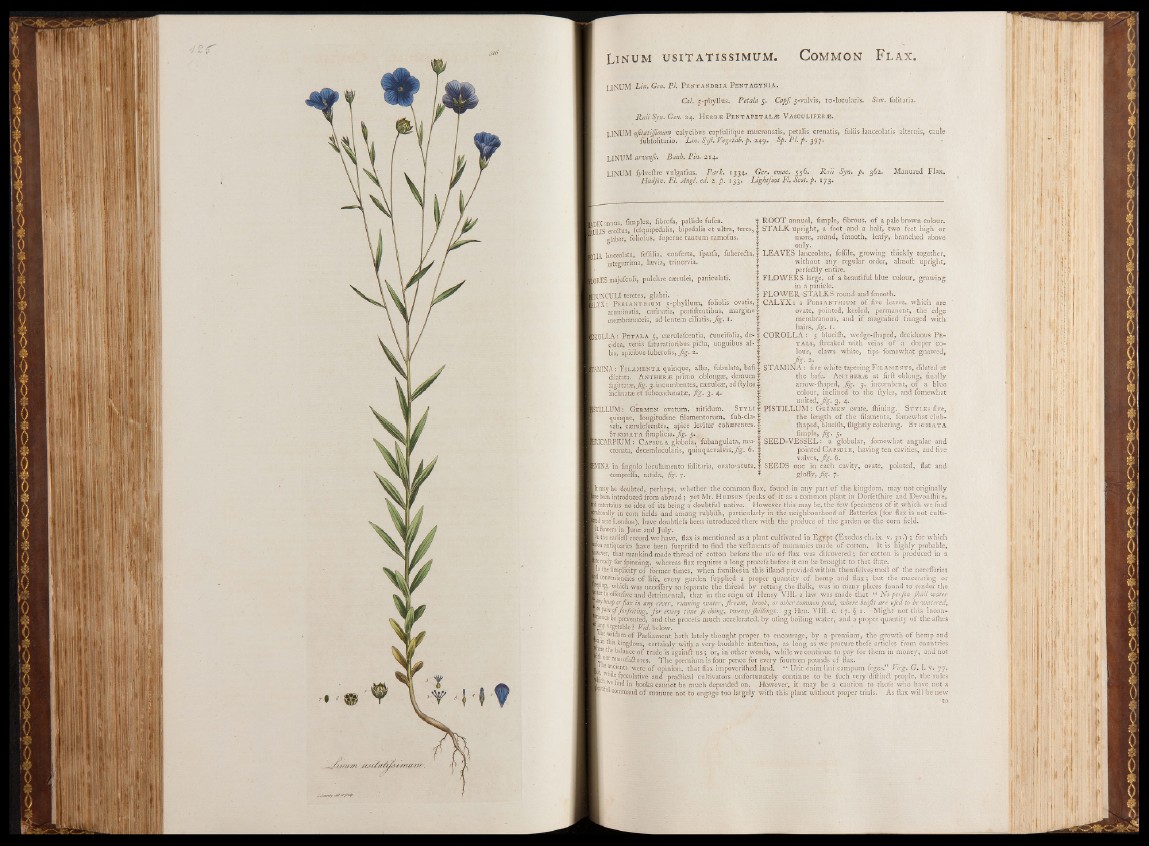
Linum usitatissimum. Common Flax,
LINUM Lin. Gen» PL Pentandria Pentag.yn ia .
Cal. 5-phyllus. Petala 5. Capf. 5-valvis, io-locularls. Sem. folitaria.
Raii Syn. Gen. 24. Herb.® Pentapetalas V asculiferjs.
LINUM ufitatißimum calycibus capfulifque mucronatis, petalis crenatis, foliis laneeolatis alternls, caule
(ubfolitario. Lin. Syß.Vegetab.p. 249. Sp. PL p. 397.
LINUM arvenfe. Bauh. Pin. 214.
LINUM fylvedre vulgatius. Park. 1334. Ger. emac. 556.. Raii Syn. p. 362. Manured Flax.
Hudfon. Fl. Angl. eil. 2. p. 133. Lightfoot FL Scot. p. 173.
%IX annua, (implex, fibrofa, pallide fufca.
lULlS ereCtus, lefquipedalis, bipedalis et ultra, teres,;
* glaber, foliolus, fuperne tautum ramofus.
XIA lanceolata, feflilia, conferta, fparfa, fubereCta,;
iutegerrima, laevia, trinervia.
I)RES majufculi, pulchre caerulei, paniculati.
|)UNCULI teretes, glabri.
XYX: Pebianthium 5-phyllum, foliolis ovatis,,
acuminatis, carinatis, perfidentibus, margine
membranaceis, ad lentem ciliatis, Jig. 1.
kOLLA: Petala 5, casrulefcentia, Cuneifolia, decidua,
venis faturatioribus piCta, unguibus al-
bis, apicibus fuberofis, Jig. 2.
lAMINA : Fi lament A quinque, alba, fubulata,'bafi
dilatata. A nther.® primo oblongas, demum
fagittatae,y%. 3. in cum ben tes, casruleas, ad dylos
iaclinatas et fubcoadunatas, fig. 3. 4.
ROOT annual, (imple, fibrous, of a pale brown colour.
STALK, upright, a foot and a half,, two feet high or
more, round, fmooth, leafy, branched above
only.
LEAVES lanceolate, feflile, growing thickly together,
without any regular order, almoft upright,
perfectly entire.
FLOWERS large, of a beautiful blue colour, growing
in a panicle.
FLOWER-STALKS round and fmooth.
CA L YX : a Perianthium of five leaves, which are '
ovate, pointed, keeled, permanent, the edge
membranous, and if magnified fringed with
hairs, Jig. 1.
CO ROL LA : 5 blueilh, wedge-(haped, deciduous Petals,
Areaked with veins of a deeper co-
: lour, claws white, tips fomewhat gnawed,
j?!'. • Jig. 2.
■ STAMINA : five white tapering F ilaments, dilated at
; the bafe. . Anthers at firft oblong, finally
\ arrow-(haped,Jig. 3. incumbent, of a blue
r' colour, inclined to the ftyles, and fomewhat
I united, fig. 3, 4.
ITILLUM: Germen ovatutn, nitidum. St y l i $ PISTILLUM: GeR men ovate, (hining. St yles five, .
quinque, longitudine filamentorum, fub-cla-| the length of the filaments, fomewhat clubvati,
casrulefcentes, apice leviter cohasrentes. | (haped, blueilh, flightly cohering. Stigmata
Stigmata fimplicia, fig. 5., | fimple, fig. 5.
«RICARPIUM: Capsul a globofa, fubangulata, mu-1 SEED-VESSEL: a globular, fomewhat angular and
cronata, decemlocularis, quinquevalvis,^. 6. ? pointed Capsule, having ten cavities, and five
| valves, fig. 6. ,
IMINA in fingulo loculamento (olitaria, ovato-acuta, * SEEDS one in each cavity, ovate, pointed, flat and
comprefla, nitida, fig. 7. * glofly, fig. 7.
lit may be doubted, perhaps, whether the common flax, found in any part of the kingdom, may not originally
je been introduced from abroad ; yet Mr. Hudson fpeaks of it as a common plant in Dorfetlhire and Devon (hi re,
B entertains no idea of its being a doubtful native. However this may be, the few fpecimens of it which we. find
gfionally in corn fields and among rubbifh, particularly in the neighbourhood of Batterfea (for flax is not culti-
|ed near London), have doubtlefs been introduced there with the produce of the garden or the corn field;
|t flowers in June and July.
Jn the earlieft record we have, flax is mentioned as a plant cultivated in Egypt (Exodus ch. ix. v. 31.) ; for 'which
n antiquaries have been furpriled to find the vedments of mummies made of cotton. It is highly probable,
iwever, that mankind made thread of cotton before the ufe of flax was difcovered ; for cotton is produced in a
P ready for fpinning, whereas flax requires a long procefs before it can be brought to that date.
P the fimplicity of former times, when families in this ifland provided within themfelves mod of the neceflaries
g ronveniencies of life, every garden fupplied a proper quantity of hemp and flax; but the macerating or
j|pmg, which was lieceflary to leparate the thread by rotting the dalk, was in many places found to render the
get fo offenfive and detrimental, that in the reign of Henry VIII. a, law was made that “ No per Jon Jhall water
WH hemp or flax in any river, running water, fireamy brook, or other common pondwhere beafis are ujed to be watered,
jMpflra tfforfeiting, for every time fo doing, twenty Jhillings. 33 Hen. VIII. c. 17. § 1. Might not this incon-
tniei,ce be prevented, and the procefs much accelerated, by ufing boiling water, and a proper quantity of the allies'
P’'y vegetable ? Fid. below.
Ihewifdom of Parliament hath lately thought proper to encourage, by a premium, the growth of hemp and
I this kingdom, certainly with a very laudable intention, as long as we procure thefe articles from countries
,6re the balance of trade is again A us; or, in other words, while we continue to pay for them in money, and not
V°ur manufactures. The premium is four pence for every fourteen pounds of flax.
pe ancients were of opinion, that flax impoveriflied land. “ Urit enim lini campum feges.” Virg. G. I. vv 77.
while fpeculative and practical cultivators. unfortunately continue to be fuch very didinCt people, the rules
If books cannot be much depended on. However, it may be a caution to thofe who have not a
J u Comtnand of manure not to engage too largely with this plant without proper trials. As flax will be new